Strengthen your heart, bones – and maybe even your brain: a beginner’s guide to weight training at any age
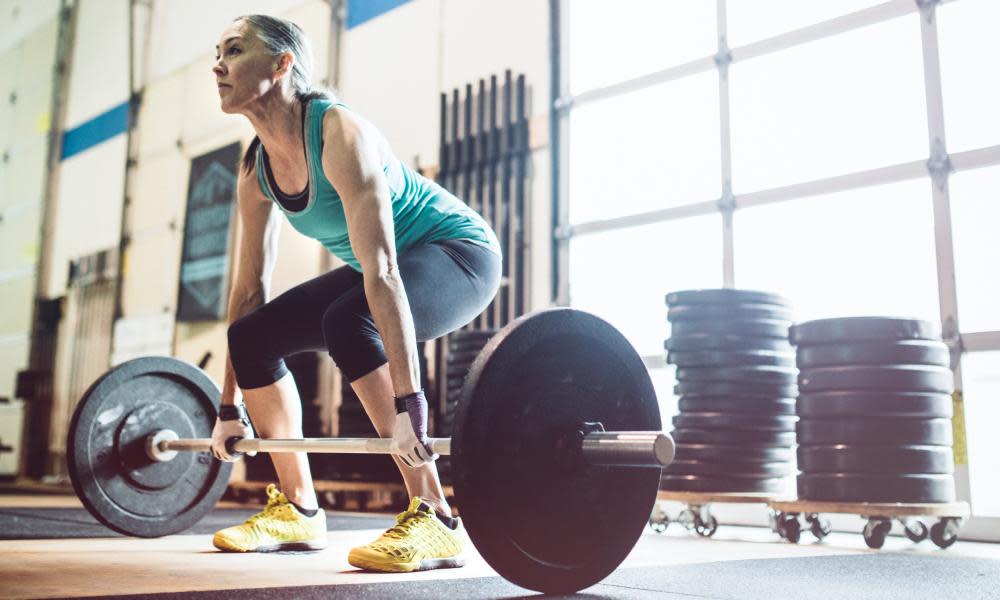
‘I got obsessed with watching Olympic weightlifting during London 2012,” says Fiona Clements, a software developer working in London. “I think it’s partly because the effort is so visible – you can see every flicker of doubt, pain and triumph on the athletes’ faces. I was 48 at the time. I thought I’d left it far too late to even consider trying it, but then I kept thinking about it. It took until September 2022, but I finally went for it.” Now 58, Clements can deadlift 50kg and push 21kg overhead. She says she has never felt stronger.
Resistance training, to use the catch-all term for any sort of exercise where you’re working against weight, whether it’s using dumbbells, exercise bands or just your own body weight, has a lot to recommend it. It makes you stronger and more injury-resistant by increasing bone density and strengthening the muscles, ligaments and tendons around your joints. It mitigates the risk of everything from falls to osteoporosis as you age. It can burn calories and reduce body fat more efficiently than cardio, by keeping your metabolism elevated for days after each workout. Plus, it’s more effective for flexibility than certain styles of stretching.
Strength training can reduce blood pressure, lower cholesterol and improve circulation by strengthening the heart and blood vessels – and probably protects against heart disease. It improves mood, might help with your risk of depression and seems to have protective effects against dementia and cognitive decline. It also just makes life a bit easier: from moving a sofa when it’s time to do the vacuuming to wrangling your carry-on into an overhead locker, things are often simpler with just a bit of extra strength.
So why don’t more people do it? A survey published in May suggests that, even though 67% of UK adults meet the current guidelines for aerobic activity, only 7.3% of men and 4.1% of women achieved the recommendations for strengthening activity. As the UK population ages, it should be a no-brainer, whether you’re hoping to stave off osteoporosis or hoist your grandchildren aloft when they come to visit. But for many people, strength training comes with a few sticking points.
“I just thought that it would be impossible to make a difference to my body as an older woman,” says Joanna Blacker, a small business owner and recently qualified personal trainer from west London, who took up strength training at 53. “I’d been through the menopause, gained weight and felt awful. I certainly didn’t think that weightlifting would be the way I would change my body – I thought I should be doing lots of class-based, aerobic style exercise. You think of gyms as full of muscled guys strutting around hogging all the weights. You wouldn’t want to step in not know what you’re doing.”
This attitude isn’t uncommon. Running, to take the nation’s favourite cardio activity, is something you can do alone and unsupervised; lifting weights is something that most people associate with going to a gym or working with a trainer. Running is simple, and the goals are clear: get a bit faster, do it for a bit longer without stopping, maybe do a 5k or (if you’re keen) a marathon. Weights are intimidating and there’s always a niggling feeling that if you push it too hard, you’ll end up worse off than before you started.
Perhaps most importantly, running includes a single movement pattern that every human naturally understands; lifting has dozens, and it’s not clear which ones you need to focus on. The fragmented nature of the fitness industry doesn’t help: the qualifications you need to work as an entry-level personal trainer in the UK teach very little about practical strength training, focusing instead on machines or teaching classes.
So how do you get around these problems? First, by remembering that you do not need to join a gym. “It’s a building with some fitness equipment, not some sort of holy ground where fitness must take place,” says Andrew Tracey, fitness editor for Men’s Health. “By not outsourcing your fitness to ‘somewhere else’ you’ll save a fortune on gym membership, parking fees and fuel. You’ll also remove all of those things as obstacles every time you think: ‘I can’t be bothered.’ It’s a lot harder to say ‘no’ when all you’ve got to do is walk into your garage or spare room.”
Related: Exercise with weights linked to lower risk of early death, study says
Next up: realising that your body understands resistance as resistance – dumbbells and kettlebells (those cannonball-style weights with a handle at the top) are just one convenient form. “You can start by using your own body weight and objects around the house,” says Sally Moss, a strength coach who specialises in Olympic lifting. “For example, you can use your stairs to help you do a push up by putting your hands on a high step, or use a chair to do a step up.”
If you’re ready to invest in some equipment, you can go a long way with not very much. “The equipment you need is going to come down to your budget, goals and space – and the things you actually enjoy doing,” says Tracey. “But you can go a long way with nothing but a pair of medium-weight dumbbells – that combined add up to 25% of your body weight – somewhere to do pull-ups or rows, and some resistance bands [like giant rubber bands of varying strengths]. If you want to lift serious weights but you’re on a budget, a sandbag is the most economical way to get strong – throw some sand in freezer bags, tape them shut to reduce the risk of leakage, then toss them all in an old rucksack and you’ve got the perfect adaptable training tool.”
As for the movements, this bit is simpler than it sounds. “It’s a good idea to start each session by picking a few exercises that work on your biggest-hitting ‘movement patterns’ – pushing, pulling, squatting and hip-hinging [a movement where you ‘hinge’ at the hips], as in deadlifts or kettlebell swings,” says Tracey.
“You can easily combine these to speed up your workout, while adding a little cardio element at the same time. Think press-ups going directly into a higher-rep [higher-repetition] set of squats. [See the FAQs if you’re confused by talk of sets and reps.] Mix these movements up from session to session and keep track of your reps and sets so you’ve got ‘high scores’ to beat. Once you’ve done the meat and potatoes, you can use your bands for ‘accessory movements’ if you want to – think biceps curls.”
Related: Lift your way to strength – and help your body stay young
If planning alone is still too intimidating, there’s always the option of getting some tuition. “Last Christmas, I got to the point where it was do or die and signed up with the gym Ultimate Performance,” says Blacker. “I thought I’d need a lot of motivation, but I actually didn’t – I saw results quite quickly and I just wanted to learn more about how to do things correctly.”
Clements signed up for a beginner’s class with Moss, and loved it from her first session. “My school was obsessed with team sports involving hand-eye coordination, and I came away thinking that anything with a coach wasn’t for me – but within five minutes of walking in the door of the gym, I thought: ‘Yes, these are my people.’”
Blacker can now bench-press 40kg for 10 reps and feels more than ready to tackle training alone. Clements, meanwhile, has already signed up with her local gym, for the days she’s not training with Moss. “I can feel these bands of hard muscle when I flex that I’m pretty sure weren’t there before,” she says. “But the best part is that I’m actually able to understand the sport I love. It still feels like magic when that bar goes overhead.”
Strength training from scratch
To get started with strength training, don’t overcomplicate it – get familiar with a handful of moves that hit the main movement patterns, then mix and match them according to how many times you’d like to train in a week. Here are a few to begin with:
Horizontal push: press-up
The one move everyone knows is among the best for upper-body strength – as long as you do it properly. Perfect form is to start with your hands directly under your shoulders, keep your body in a plank-like position, tuck your elbows to your sides to reduce strain on your joints, and touch your chest to the floor at the bottom of each “rep” (repetition). If you can’t do a single rep, start with your hands on a step, sofa, or even a wall to make it easier. (Knee press-ups, which are often suggested as an alternative, reduce your core’s involvement, so they aren’t a great way of working up to the full version.)
Also try: dumbbell bench press, dips
Horizontal pull: bent row
This is the most basic “pulling” move, and something you can do with any sort of improvised weight – or if you’re feeling fancy, a resistance band. Bend at the waist – your back should be straight and at about 45 degrees from vertical – and “row” the weight to your ribs by pulling your elbows behind you, keeping them tucked in. Keep the weight light enough to let you pause at the top of the movement.
Also try: pull-ups, inverted rows

Vertical pull: pull-up
If you’ve never done these before it’s unlikely you’ll manage one on your first go, but pulling moves are important for posture. Keeping a bar up in your house – there are lots that will clip securely on to a doorway – makes them a fun challenge. Start with “negatives” – use a little jump to get your chin higher than the bar, then lower yourself slowly to a near-hang, and repeat. A quick reminder: technically, in pull-ups your hands face away, while in chin-ups they face towards you. The former are better for your back, while the latter build your arms.
Also try: inverted rows

Vertical push: dumbbell press
Your best bet for vertical pressing if you aren’t up to handstand press-ups – dumbbell presses are shoulder-friendly and equally possible with kettlebells or soup cans. Start with the weights at your shoulders, brace your core and press straight overhead, letting your hands rotate naturally as you go through the movement. Slow and controlled is the winner here.
Also try: one-armed overhead press, push press
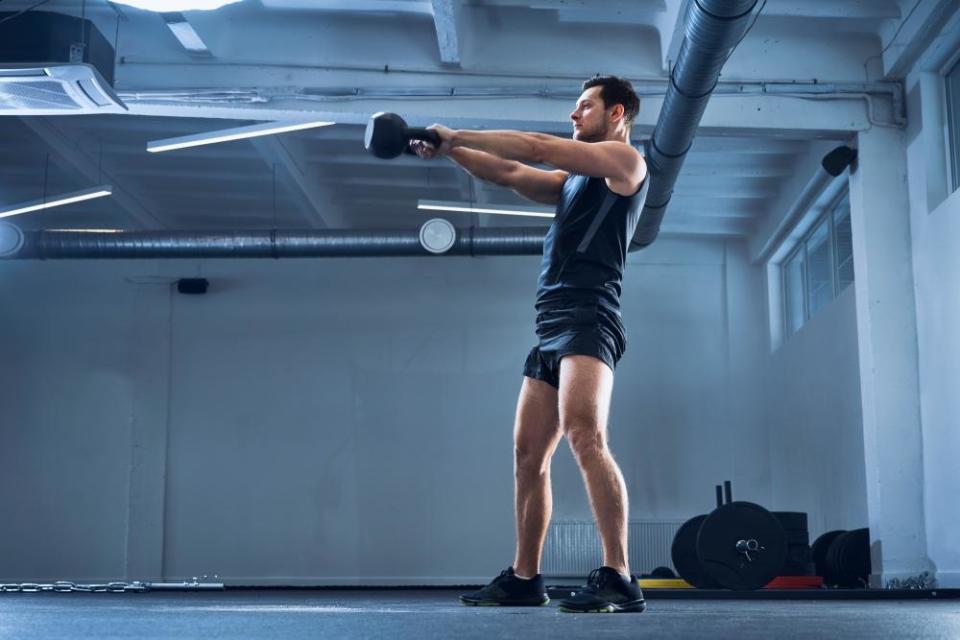
Hip hinge: kettlebell swing
To get this one right, remember that it’s a dynamic movement – in most moves, using momentum to complete the rep is verboten, but here it’s a must. Swing a kettlebell or dumbbell back between your legs, bend your knees slightly, then straighten up and drive your hips forward to swing the bell up to roughly chest height. Don’t squat and don’t do a front raise.
Also try: jump squats
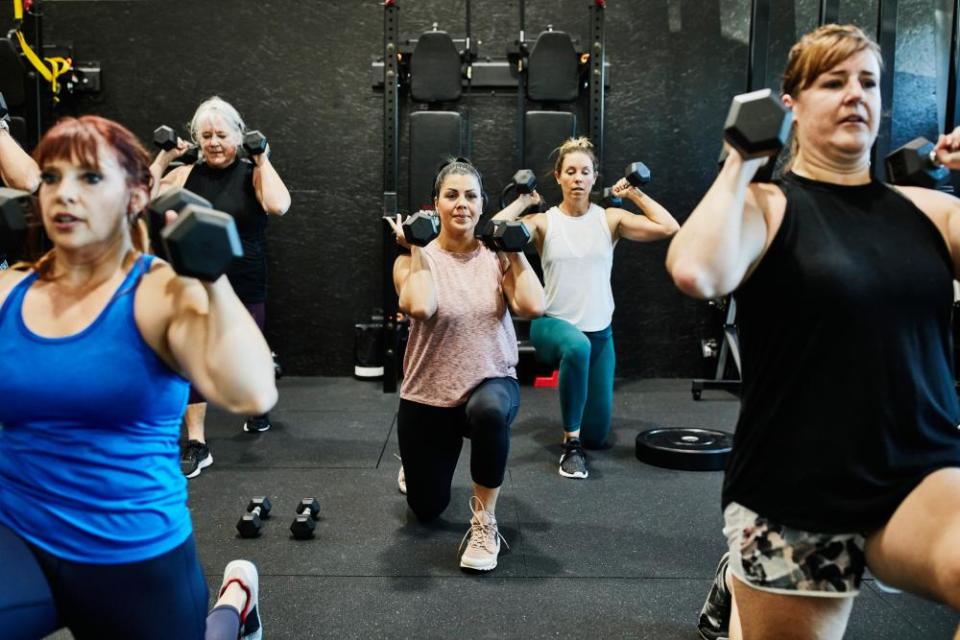
One-legged movement: reverse lunge
Often a little less wobbly than its forward variation, so a great place to start. From a standing start, take a big step backwards and bend your leading leg until your trailing knee just brushes the floor. Return to a standing position, then repeat on the other leg. You can weight this in lots of ways – a dumbbell in each hand, a rucksack full of books, or a “goblet” style hold as below – but master the weight-free version first.
Also try: lunges, walking lunges, step-ups

Squat: goblet squat
One of the best forms of squat, as it’s almost entirely self-correcting. Hold a dumbbell in front of you with both palms on end, as if you’re holding a medieval goblet – then keep your weight on your heels as you squat, aiming to bring your elbows inside your knees. If you stray into the forward lean that plagues many barbell squatters, you’ll lose control of the weight – and by pausing for a few seconds at the bottom of the movement, you’ll build strength and mobility.
Also try: bodyweight squats, back squats, front squats
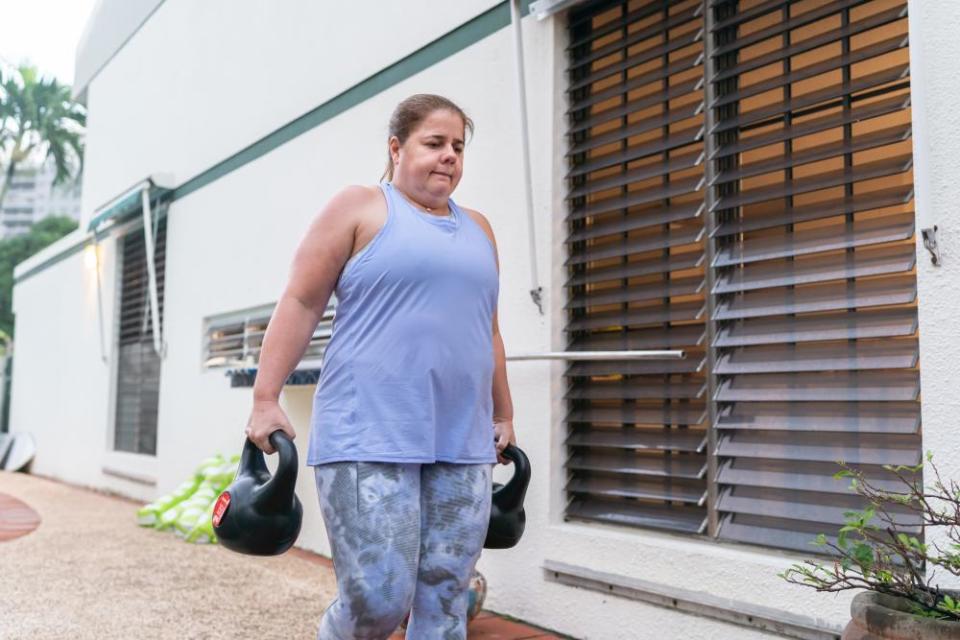
Carry: suitcase carry
You can skip this one if you regularly carry your own shopping – but if your delivery guy gets more exercise than you, add it to your plan. Hold a heavy dumbbell, kettlebell or rucksack in one hand, walk for a few metres, then switch hands and walk back. Brace your core to keep yourself upright, and keep your other arm out for balance if you need to.
Also try: farmer’s walk, waiter’s walk
The workouts
These two short workouts use “supersets” – two moves, done without rest, to add a cardio element and make your training time go further. Add them to your weekly routine to make a simple start with strength training – if you’ve got time for more, just alternate between them.
Related: My workout: ‘I worried I’d get big if I did powerlifting, but I’ve dropped a dress size’
Workout 1
1A Press-up Sets 3 Reps 8
1B Bent row Sets 3 Reps 8
2A Goblet squat Sets 3 Reps 12
2B Kettlebell swing Sets 3 Reps 15
Workout 2
1A Dumbbell press Sets 3 Reps 8
1B Pull-up Sets 3 Reps 3
2A Lunge Sets 3 Reps 8 each leg
2B Suitcase carry Sets 3 Distance: 10m on each side
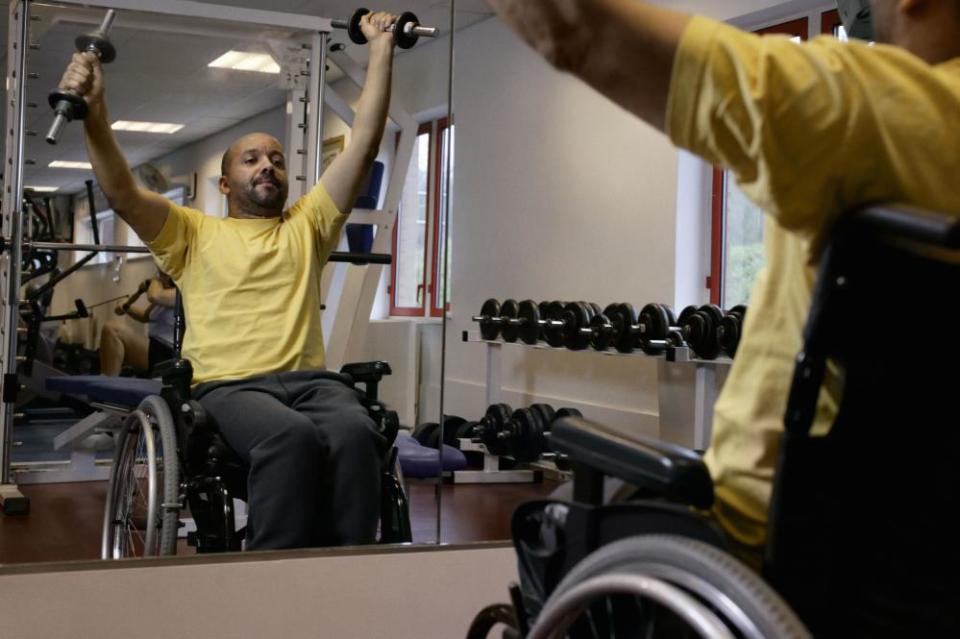
FAQs
What are sets and reps?
Reps are simply repetitions – it’s the number of times you do an exercise before you stop for a rest. Sets are simply groups of reps. So 10 press-ups, followed by a rest, followed by another 10 press-ups is two sets of 10 reps.
How much weight should I use?
Enough to make the moves feel challenging, but not so much that you’re “grinding” out repetitions. As a rule of thumb, each rep should go at the same speed – once they start to slow down, stop. Pushing until you fail is useful if you want to build muscle bulk, but not for strength.
How many reps should I do?
The general rule is that using a weight that allows you to get through one to five reps builds pure strength, five to 12 helps with muscle, and anything over 12 builds muscular endurance – but there’s a fair bit of crossover. If you’re working with a light set of dumbbells or a band, there’s nothing wrong with doing reps until the speed drops off (see above).
How much should I rest?
Again, this depends on your goals: lifters aiming to do one or two reps with a near-maximal weight might rest for five minutes between sets, while if you’re training for fat loss you should keep rests to less than a minute. For strength and/or muscle, the middle ground is ideal – think 90 to 120 seconds.
How do I pick a gym?
As you learn more movements you’ll understand more about the kit you need, but for most people, the important thing is to pick a gym close enough and empty enough to let you train regularly. The most important thing is squat racks, which allow you to load up and squat or press heavy barbells rather than getting them off the floor – as well as catching the bar if you fail. You don’t want to queue for one, so make sure your gym has at least two.
OK, I’m hooked. How do I progress?
Add a book or two on training to your reading list – Easy Strength by Dan John and Pavel Tsatsouline is great – and start keeping track of your rep records in a few big movements. You’ll soon be planning your weeks around your gym sessions.

